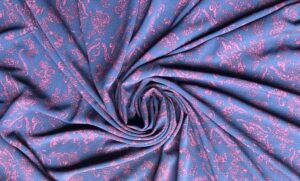The price of Crepe Material in Nigeria varies from NGN 1500 to NGN 2500 a yard, depending on the kind.
Crepe fabric is a robust textile that seems and feels soft. It can take a lot of wear and tear because it is constructed of polyester and spandex, which makes it incredibly strong and flexible.
The fact that crepe fabric may be used for both men’s and women’s apparel is its best feature. This means that everything from gowns to suits to shirts can be made of crepe fabric. Crepe material is available in a wide range of hues, giving you a lot of alternatives when it comes to designing your next outfit or fashion endeavor!
Crepe fabric is a robust textile that seems and feels soft. It can take a lot of wear and tear because it is constructed of polyester and spandex, which makes it incredibly strong and flexible.
The fact that crepe fabric may be used for both men’s and women’s apparel is its best feature. This means that everything from gowns to suits to shirts can be made of crepe fabric.
Crepe material is available in a wide range of colors, giving you a lot of alternatives when creating your next costume or fashion project.
How Much Is Crepe Material In Aba?
The price of Crepe Material in Aba varies from NGN 1500 to NGN 2500 a yard, depending on the kind.
How Much Is Crepe Material Per Yard In Aba?
The price of Crepe Material per yard in Aba varies from NGN 1500 to NGN 2500 a yard, depending on the kind.
How Much Is Crepe Material In Lagos?
The price of Crepe Material in Lagos varies from NGN 1500 to NGN 2500 a yard, depending on the kind.
ALSO SEE: Chinos Material

Crepe Material Types
Crepe materials come in a variety of forms depending on how they are made and the techniques that are employed. In this part, we’ll quickly explore the most popular crepe material varieties.
-
Crepe de Chine
One of the lightest types of crepe materials available is this one. One of the main factors in its light weight is the majority of it is comprised of silk fiber. The puckered surface that distinguishes all other crepe materials is absent from crepe de Chine. Instead of this, the silk fabric has a matte feel that is smooth with just a hint of pebbling.
The producer uses a plain-weave design to tightly twist strands into weft threads to create this appearance. Polyester is used to create the Crepe de Chine that is more reasonably priced. Although it resembles silk, it is less expensive.
-
Crepe Georgette
The crepe georgette material is fairly soft, as is to be expected with crepe textiles. Its surface is also smooth. Either natural silk fiber or synthetic fiber that closely resembles silk was used to make this product. A typical illustration of this is rayon.
Crepe georgette made from silk fibers has a moderate amount of stretchiness. It does, however, have a wonderful drape. It makes sense why it is so well-liked for feminine dresses.
-
Wool Crepe
Knowing anything about wool will lead you to predict that the wool crepe will be more rugged than silk. In some circumstances, cotton and synthetic textiles are used to make a wool crepe. This product has a wiry surface and is between light and medium weight in weight. You may sew dresses, slacks, and suits using it.
-
Polyester Crepe
Any crepe fabric produced using synthetic fibers is referred to as polyester crepe. The polyester crepe is equally as light as the silk Crepe de Chine. In addition to having a lightweight fabric, it also has a lovely drape. Making blouses, pants, and skirts are just a few of the many uses for this kind of crepe. To make the crepe stretch, you might need to add elastane.
-
Crepe-back satin
Crepe-back Satin is a two-purpose kind of cloth. It is smooth and silky on one side due to the satin-like material covering it. The feel and sight of crepe are presented to you on the opposite side.
-
Canton Crepe
Originally, this kind of crepe was produced from silk. The name of the fabric is explained by the fact that the silk came from the Chinese province of Canton. This kind of crepe and crepe de Chine has a lot in common in terms of appearance and texture. The canton crepe only differs in that it feels heavier due to the use of stronger fill yarns in the weave.
-
Plisse Crepe
The chemical treatment of fabric produces this kind of crepe. It produces a folded pleat by giving the plisse crepe a puckered and crinkled appearance.
The pattern is created by pressing a single piece of fabric with hot rollers. The fabric can also be covered in a wax pattern and then submerged in an alkaline solution. When the wax is removed, the cloth’s fibers wrinkle, and the portions of the fabric not covered in wax shrink.

Leave a Reply